El Galpon
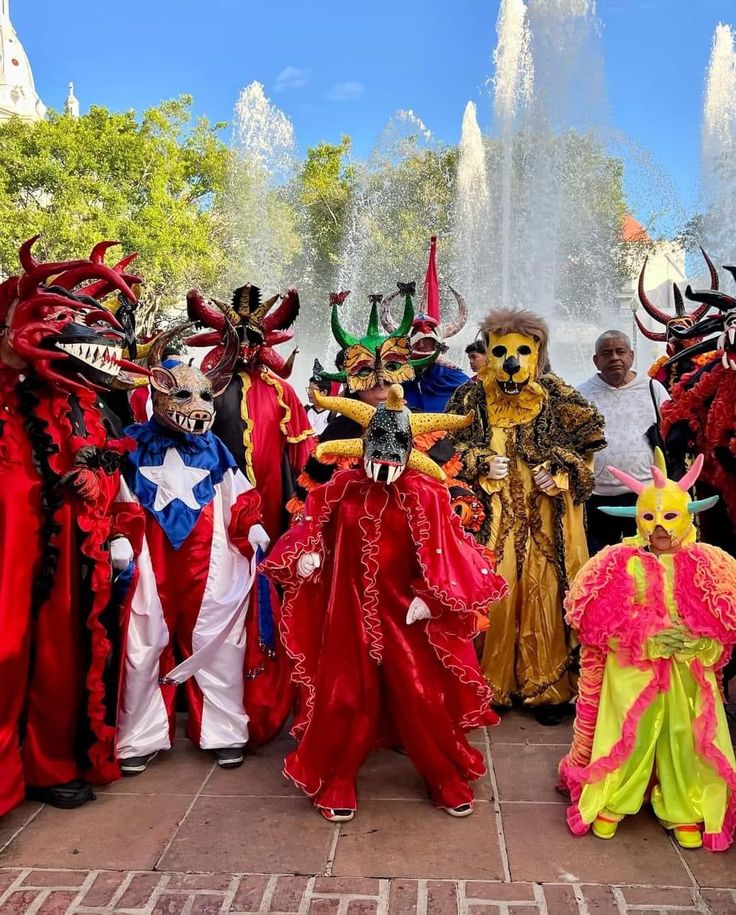
El Galpon
El Carnaval en Puerto Rico - Un Legado de Historia y Tradición
Desde las históricas calles empedradas del Viejo San Juan, en El Galpón de Puerto Rico, somos testigos y partícipes de la rica herencia cultural que define a nuestra isla. El Carnaval, con su vibrante despliegue de color, música y tradición, es una ventana al pasado y un reflejo de la identidad puertorriqueña.
Orígenes Históricos - Un Viaje a Través del Tiempo:
Los carnavales en Puerto Rico tienen sus raíces en la primera mitad del siglo XIX, específicamente en la década de 1820. Originalmente, eran celebraciones de carácter religioso, marcando el inicio de la Cuaresma con un último festín de carne. Sin embargo, con el tiempo, el Carnaval evolucionó, integrando elementos folclóricos y adaptándose a los cambios sociales y políticos.
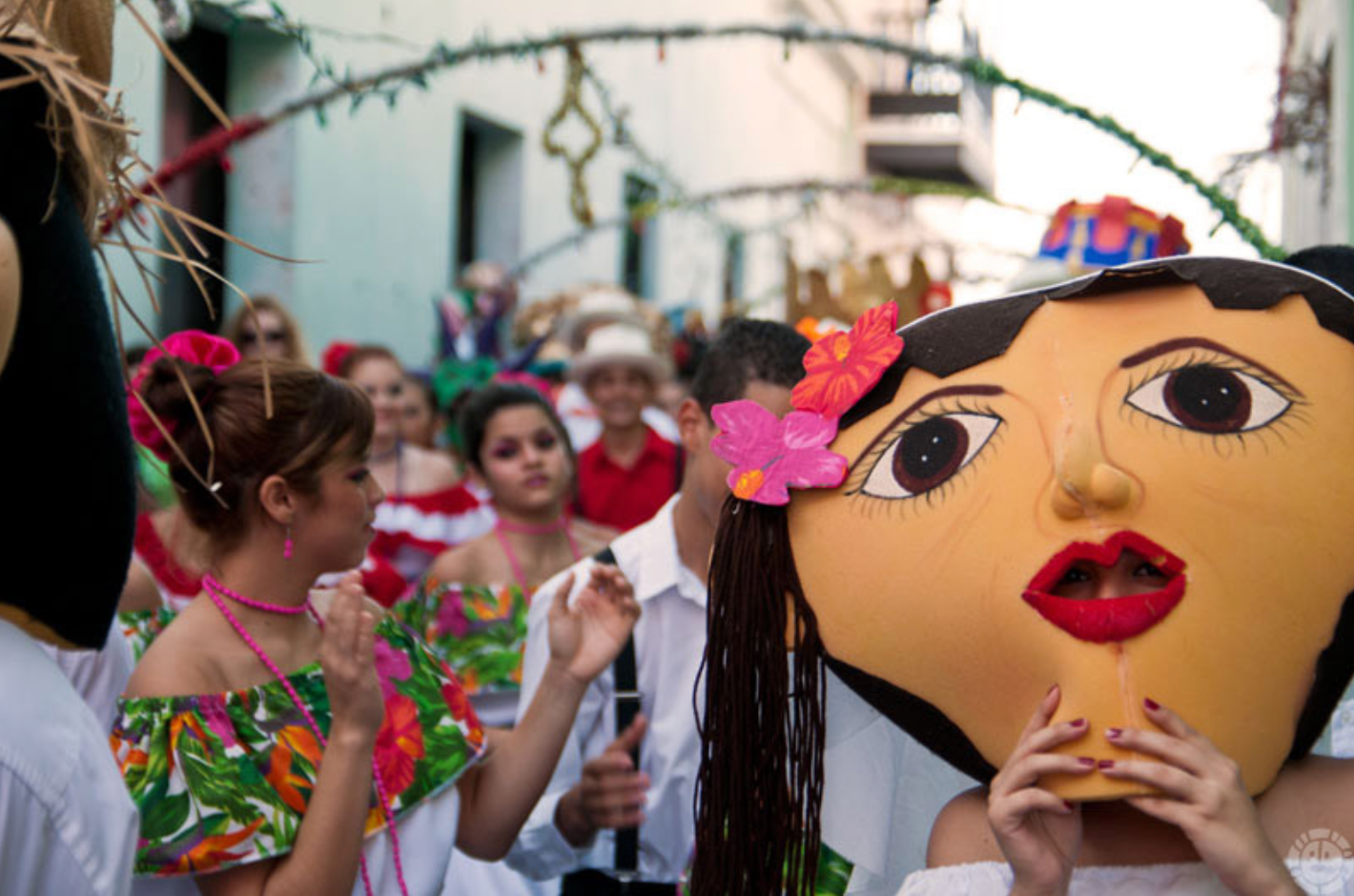
El Galpon
Del jueves 16 al domingo al 19 de enero de 2025
Un viaje en el tiempo
Desde sus humildes comienzos en la década de 1950, las Fiestas de la Calle San Sebastián han evolucionado hasta convertirse en una de las celebraciones más emblemáticas de Puerto Rico. Nacidas con el propósito de recaudar fondos para la Iglesia de San José, estas fiestas rápidamente se transformaron en un espacio de encuentro, música, baile y expresiones culturales.
Inicios modestos: A mediados del siglo XX, específicamente en 1954, el párroco de la Iglesia de San José, ubicada en el Viejo San Juan, organizó una pequeña fiesta para recaudar fondos y reparar la iglesia. La idea era celebrar al santo patrón y, al mismo tiempo, unir a la comunidad.
El impulso de Doña Rafaela Balladares: A finales de los años 60, Doña Rafaela Balladares, una líder comunitaria y figura clave en la historia de las fiestas, revitalizó las celebraciones. Con su visión y entusiasmo, las fiestas comenzaron a crecer y a ganar popularidad.
Inclusión de los Cabezudos: Una de las aportaciones más significativas de Doña Rafaela fue la incorporación de los Cabezudos, grandes figuras con cabezas de cartón que representan a personajes históricos. Estos Cabezudos desfilan por la calle San Sebastián al ritmo de música afroantillana, añadiendo un toque de color y alegría a la festividad.
El sombrero panamá y los Cabezudos: una combinación perfecta
La imagen de un Cabezudo con un sombrero panamá es icónica. Esta combinación representa la fusión entre la tradición y la modernidad, entre lo popular y lo sofisticado. El sombrero panamá aporta un toque de elegancia a estos personajes alegóricos, convirtiéndolos en símbolos aún más reconocibles de nuestras fiestas.
El sombrero panamá: un accesorio de leyenda
En medio de este hervidero de color y alegría, el sombrero panamá ha sido un testigo fiel de la evolución de las fiestas. Desde los elegantes caballeros que los lucían en los primeros años, hasta los jóvenes que hoy los combinan con los estilos más modernos, el sombrero panamá se ha convertido en un símbolo de identidad y estilo puertorriqueño.
55 años después...
Hoy, las Fiestas de la Calle San Sebastián son una celebración que trasciende fronteras. Miles de visitantes acuden cada año al Viejo San Juan para disfrutar de la música, la comida, la artesanía y, por supuesto, de la alegría de nuestro pueblo. Y en medio de esta fiesta, el sombrero panamá sigue siendo un protagonista indiscutible.
En El Galpón, celebramos contigo
En estos 55 años de historia, El Galpón se enorgullece de ser parte de esta tradición. Nuestros sombreros panamá han acompañado a generaciones de puertorriqueños en sus celebraciones más importantes. Y este año, queremos seguir siendo parte de tu fiesta..
Visítanos y descubre nuestra colección completa de sombreros panamá, relojes de madera, gafas de sol y otros accesorios que complementarán tu estilo durante las Fiestas de la Calle San Sebastián y todo el año.
Te esperamos en Nuestro Local:
154 Calle del Cristo, San Juan, 00901, Puerto Rico
Visita Nuestra Web:
http://elgalpon.net
Amplia variedad de estilos: Descubre una amplia gama de sombreros panamá, desde los clásicos hasta los más modernos.
Relojes de madera únicos: Encuentra el reloj de madera perfecto para complementar tu estilo personal.
Gafas de sol con estilo: Protege tus ojos con estilo gracias a nuestras gafas de sol de madera.
Accesorios exclusivos: Complementa tu look con nuestros exclusivos accesorios, como anillos, pantallas y collares.
Envíos a todo Puerto Rico y EEUU: Recibe tus productos cómodamente en tu hogar.
¡No te pierdas la oportunidad de lucir a la moda durante las Fiestas de la Calle San Sebastián!
---
55 Years of Flavor and Tradition in San Juan: A journey through the history and culture of the San Sebastián Street Festivals
From Thursday 16 to Sunday to January 19, 2025
A trip in time
Emerging from modest beginnings in the 1950s, when local residents organized small gatherings to raise funds for the Church of San José, the San Sebastián Street Festivals have evolved into one of Puerto Rico's most iconic celebrations. The lively sounds of salsa, bomba, and plena filled the air as neighbors gathered, dancing in the streets and sharing stories under the starry sky. These festivals quickly became a unique blend of religious devotion, vibrant music, and community spirit, transforming a simple fundraising effort into a beloved cultural tradition.
Modest beginnings: In the mid-20th century, specifically in 1954, the parish priest of the Church of San José, nestled within the historic heart of Old San Juan, conceived a simple plan: a small community gathering to raise funds for much-needed church repairs. This initiative, born from a desire to honor the patron saint and foster a sense of community, would soon blossom into a vibrant cultural phenomenon.
The impulse of Doña Rafaela Balladares: Doña Rafaela Balladares, a visionary community leader, played a pivotal role in revitalizing the celebrations in the late 1960s. With her infectious enthusiasm, she spearheaded efforts to expand the festival's scope, attracting more vendors, musicians, and community participation. Doña Rafaela Balladares's vision and tireless efforts laid the foundation for the San Sebastián Street Festivals to become the beloved cultural phenomenon they are today.
Inclusion of the Big Heads: One of Doña Rafaela Balladares's most significant contributions was the inclusion of the Cabezudos, large figures with cardboard heads that represent historical figures such as politicians, artists, and local celebrities. These vibrant Cabezudos, adorned with colorful costumes, dance and prance down San Sebastián Street to the infectious rhythms of Afro-Antillean music, filling the air with laughter and creating a truly unforgettable spectacle.
The Panama hat and the Cabezudos: a perfect combination
The image of a Cabezudo adorned with a Panama hat has become iconic. The Panama hat, with its delicate weave and timeless style, adds a touch of sophistication to the Cabezudos, creating a striking visual contrast against their often playful and whimsical designs. This unique combination of the traditional Cabezudo with the refined Panama hat has become an instantly recognizable symbol of the San Sebastián Street Festivals, instantly evoking images of vibrant music, lively dancing, and the spirit of the Puerto Rican people.
The Panama hat: a legendary accessory
Amidst the vibrant tapestry of colors and the infectious rhythms of music, the Panama hat has been a faithful witness to the evolution of the holidays. From the elegant gentlemen who adorned their heads with these finely woven hats in the early years, to the young people who today seamlessly blend them with contemporary styles, the Panama hat has become an enduring symbol of Puerto Rican identity and style, gracefully adorning the heads of generations of revelers and seamlessly blending with the vibrant energy of the festival.
55 years later...
Today, the San Sebastián Street Festivals have evolved into a major cultural event, attracting thousands of visitors from around the world to Old San Juan each year. They come to experience the vibrant music, savor the delectable cuisine, browse the unique crafts, and immerse themselves in the infectious joy that fills the streets. In this festive atmosphere, the Panama hat, a timeless symbol of the festival, continues to grace the heads of revelers, adding a touch of elegance and sophistication to the vibrant tapestry of the celebration.
At El Galpón, we celebrate with you
Since 1996, El Galpón has been honored to be a part of this beloved tradition, providing generations of Puerto Ricans with high-quality accessories for their special occasions. This year, we are thrilled to continue being part of your celebration. Visit El Galpón today and discover the perfect Panama hat to complete your San Sebastián Street Festival look.
We are waiting for you at Our Location:
154 Calle del Cristo, San Juan, 00901, Puerto Rico
Visit Our Website:
http://elgalpon.net
Wide variety of styles: Discover a wide range of Panama hats, from the classics to the most modern.
Unique wooden watches: Find the perfect wooden watch to complement your personal style.
Stylish sunglasses: Protect your eyes in style thanks to our wooden sunglasses.
Exclusive accessories: Complement your look with our exclusive accessories, such as rings, lampshades and necklaces.
Shipping to all of Puerto Rico and the US: Receive your products comfortably in your home.
Don't miss the opportunity to look fashionable during the San Sebastián Street Festivals!
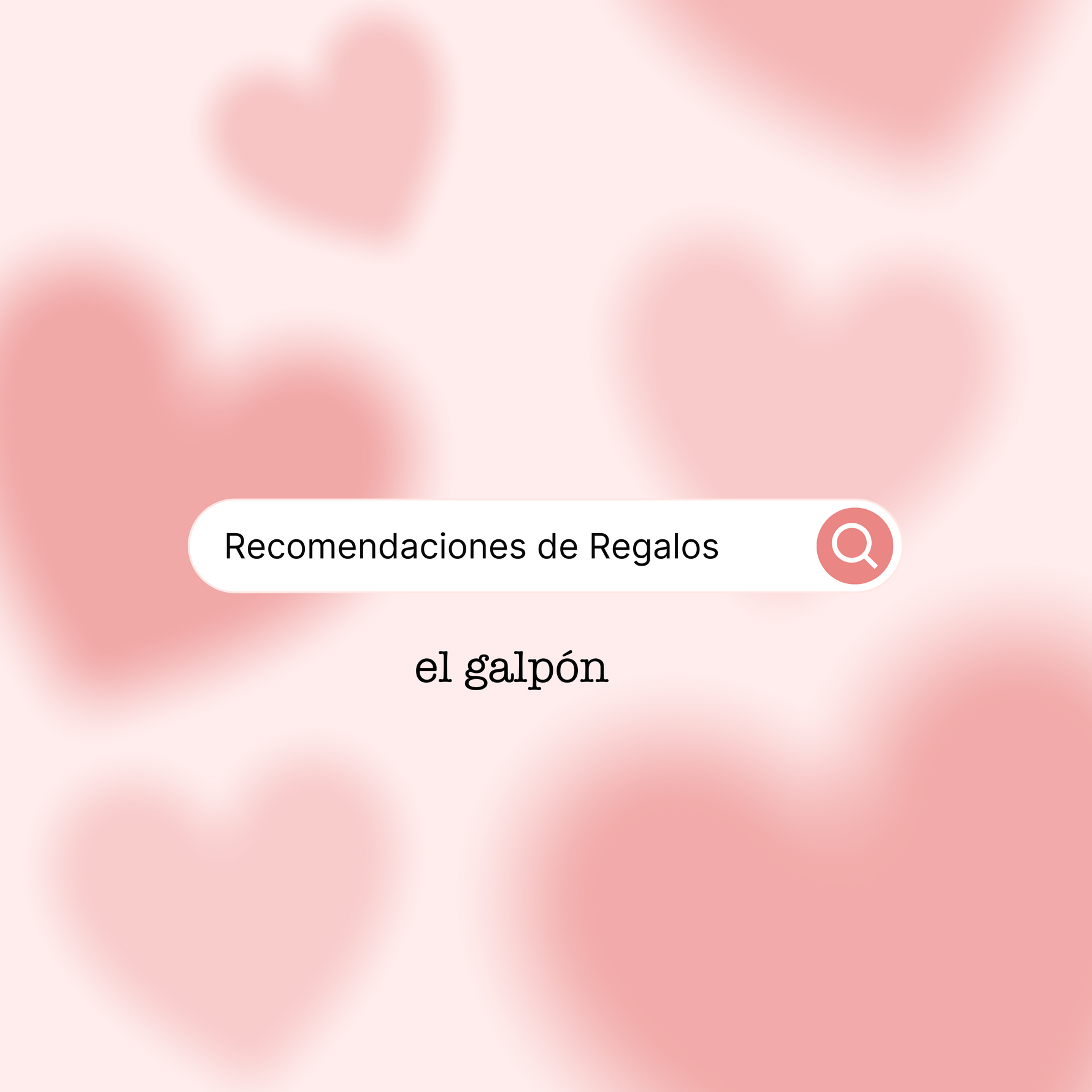
El Galpon
Regalos con Estilo para el Día del Amor y la Amistad en Puerto Rico
El Galpón, tu destino local para encontrar regalos únicos y con estilo que harán que este Día del Amor y la Amistad sea inolvidable. En este blog, te mostraremos opciones exclusivas y perfectas para sorprender a tus seres queridos.
Gorras con Diseños Exclusivos alusivos a Puerto Rico:
Las gorras son más que un accesorio; son una declaración de estilo y orgullo. En El Galpón, ofrecemos gorras con diseños exclusivos que celebran la cultura y la identidad puertorriqueña. Tenemos opciones con vibrantes colores hasta detalles inspirados en la isla. Estas gorras son el regalo perfecto para aquellos que aman destacar con autenticidad.
Relojes de Madera:
Los relojes de madera no solo son elegantes, sino que también podrian simbolizar el tiempo que compartimos con aquellos que amamos. En El Galpón, encontrarás una selección única de relojes que fusionan la artesanía con la sostenibilidad. Entre las opciones que tenemos, hay Relojes en diferentes tonos de madera y combinados con metal.
Gafas de Madera: Un Vistazo al Estilo:
Para aquellos que buscan un toque de originalidad y no les gusta perder el estilo, nuestras gafas de madera son la elección ideal. Descubre cómo fusionamos la moda con la conciencia ambiental. Gafas de madera con monturas elegantes sin dejar atras lo cool de nuestro estilo en El Galpon. Encuentra modelos mas clasicos, como avidoras, hasta estilos como cat eye y redondas,
Este Día del Amor y la Amistad, haz que tus regalos hablen con estilo. En El Galpón tenemos ese regalo perfecto que refleje el amor que sientes por tus seres queridos y por Puerto Rico. ¡Sorprende con regalos exclusivos!
Shop Now!
Tambien puedes visitarnos en nuestra tienda en el Viejo San Juan, Calle del Cristo 154.
Te esperamos… Feliz mes de amor y la amistad.
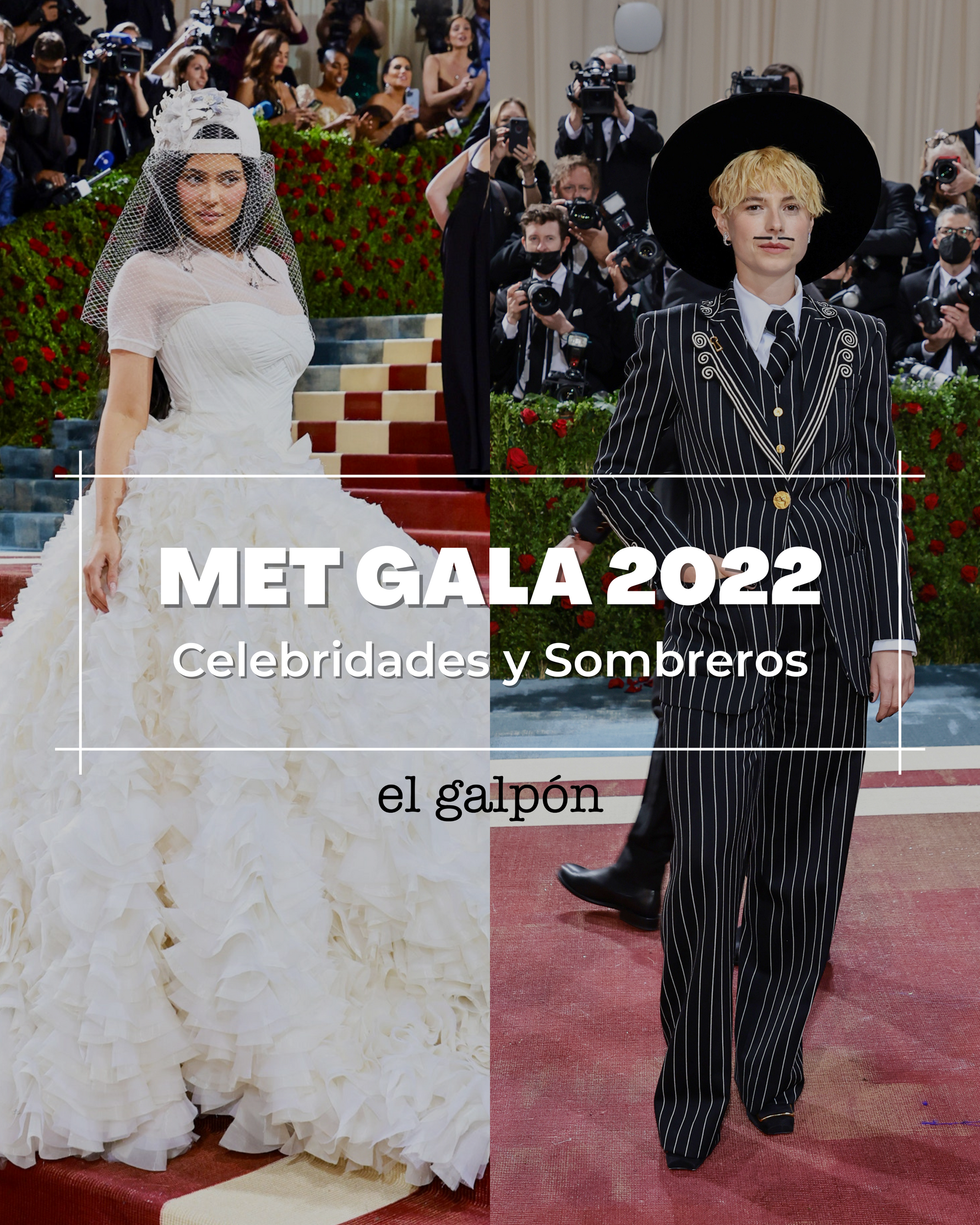
El Galpon
Met Gala 2022: Las celebridades y los Sombreros
El Met Gala ha sido uno de los eventos de moda mas importante de todos los tiempos. Celebridades, moda y creatividad se unen en una misma noche para recaudar fondos para el Museo Metropolitano de Arte en Nueva York. La alfombra roja en los emblematicos escalones del museo suele ser la protagonista de la noche. Los nombres mas importantes de la industria de la moda se unen para hacer brillar a las mejores y mas en tendencia celebridades. La gala siempre lleva un tema unico que honra la exposicion actual dentro del museo. Este año los invitados debian llevar su mejor interpretacion de “Gilded Glamour” para celebrar la exhiicion “In America: An Anthology of Fashion”.
Los sombreros siguen marcando tendencia y este año fueron parte importante de muchos looks en la Gala mas importante de la moda. Aquí te dejamos las celebridades que hicieron parte de sus look a los sombreros:
Clásicos
foto: Jamie Mccarthy / Getty Images
Jessie Buckley completo su look de traje de chaqueta y pantalón con un sombrero Cordobés con una ala extra larga.
foto: Mike Coppola / Getty Images
Autumn de Wilde en un Flat Brim Hat de Lana color Blush.
Top Hats
foto: Dimitrios Kambouris / Getty Images
Stephen Jones con un clásico y perfecto look llevo un sombrero de copa negro satinado.
foto: Kevin Mazur / Wireimage
David Harbour complemento su traje de cola perfectamente con un sombrero de copa un look característico del siglo XIX y al estilo de Abraham Lincoln.
Los EXTRAvagantes
foto: Mike Coppola / Getty Images
Leslie Odom Jr. le dio un toque diferente a su atuendo clásico de chaqueta y pantalón negro con este sombrero negro.
foto: Mike Coppola / Getty Images
Erykah Badu con su estilo siempre extravagante y étnico decidió llevar un sombrero de copa EXTRA alta forado de parches en combinación con su ropa.
Gorras
foto: Mike Coppola / Getty Images
Nicki Minaj llevo un atuendo de plumas, cuero y tul de Burberry. Agrego aun mas drama con la gorra estilo 'baseball' en cuero negro.
foto: Jamie Mccarthy / Getty Images
Kylie Jenner llego con este llamativo vestido de novia firmado por Off-White. El detalle más llamativo sin duda fue la clásica gorra de 'baseball' combinada con un velo clásico de novia.
¿Que te parecieron los looks de este año?
---
The Met Gala has been one of the most important fashion events of all time. Celebrities, fashion and creativity come together on the same night to raise funds for the Metropolitan Museum of Art in New York. The red carpet on the emblematic steps of the museum is usually the star of the night. The biggest names in the fashion industry come together to make the best and trending celebrities shine. The gala always carries a unique theme that honors the current exhibit within the museum. This year the guests had to wear their best interpretation of “Gilded Glamor” to celebrate the exhibition “In America: An Anthology of Fashion”.
Hats continue to set trends and this year they were an important part of many looks at the most important Fashion Gala. Here we leave you the celebrities who made the hats part of their look:
Classic
photo: Jamie Mccarthy / Getty Images
Jessie Buckley completed her pant suit look with a Cordovan hat with an extra long brim.
photo: Mike Coppola / Getty Images
Autumn de Wilde in a Blush Wool Flat Brim Hat.
Top Hats
photo: Dimitrios Kambouris / Getty Images
Stephen Jones with a classic and perfect look I wear a black satin top hat.
photo: Kevin Mazur / Wireimage
David Harbor complemented his train suit perfectly with a top hat, a characteristic look of the 19th century and in the style of Abraham Lincoln.
The EXTRA
photo: Mike Coppola / Getty Images
Leslie Odom Jr. put a twist on his classic black jacket and pants outfit with this black hat.
photo: Mike Coppola / Getty Images
Erykah Badu with her always extravagant and ethnic style decided to wear an EXTRA tall top hat lined with patches in combination with her clothes.
Gorras
photo: Mike Coppola / Getty Images
Nicki Minaj wore an outfit of feathers, leather and tulle from Burberry. Add even more drama with the black leather baseball cap.
photo: Jamie Mccarthy / Getty Images
Kylie Jenner arrived with this striking wedding dress signed by Off-White. The most striking detail was undoubtedly the classic 'baseball' cap combined with a classic wedding veil.
What did you think of this year's looks?
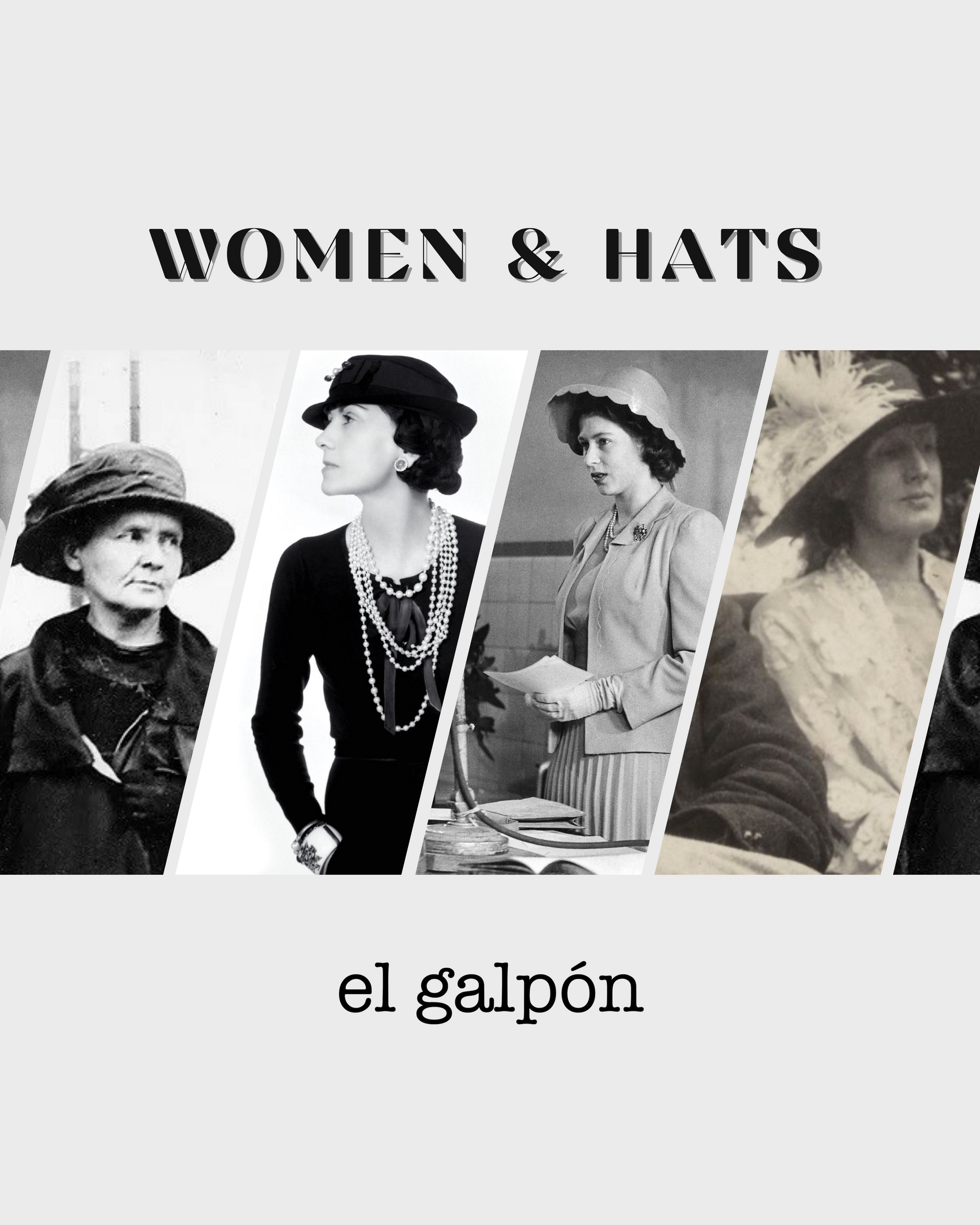
El Galpon
Mujeres que han marcado historia y sus sombreros
A través de los años, muchas mujeres han luchado por conseguir un espacio destacado en un mundo que parecía ser dominado por hombres. A lo largo de los años muchas costumbres han cambiado y los avances y esfuerzos de las mujeres han marcado un antes y después. ¡Hoy queremos presentarte algunas de las mujeres que han logrado destacar y para darle nuestro toque algunas que lo han hecho con SOMBREROS!
Marie Curie
No hay científica en la historia que haya superado en reconocimiento y fama a Marie Curie, la descubridora del Polonio y el Radio como elementos químicos. Pasó hambre y frío, y arriesgó su salud con tal de no renunciar a su pasión investigadora. Y pudiendo hacerse rica con sus descubrimientos, se negó a patentar el proceso de aislamiento del radio dejándolo a disposición de la comunidad científica. Con todo, puede decirse que cumplió su sueño: fue la primera mujer que llegó a catedrática en la Universidad de París y la primera en ganar el Nobel, compartido con su marido Pierre Curie, por sus investigaciones sobre los elementos radiactivos.
Marie acostumbraba a utilizar sombreros en sus salidas y eventos especiales. Normalmente eran sombrero en colores neutrales y con una forma redonda.
Coco Chanel
Si alguien marcó un antes y un después en el mundo de la moda esa fue Coco Chanel. Durante la Primera Guerra Mundial dejó de lado los opulentos vestidos femeninos y adaptó prendas tradicionalmente masculinas con un estilo sencillo y cómodo. También desarrolló líneas de bolsos, perfumes, sombreros y joyas. Se trata de la única diseñadora de moda que figura en la lista de las cien personas más influyentes del siglo XX de la revista Time.
Esta diseñadora de gran estilo siempre incluía en sus looks los sombreros. Increíblemente no muchos conocen que Gabrielle, nombre de pila de Coco Chanel, comenzó diseñando sombreros. En los anos 60 el sombrero era un accesorio de estatus y tenemos claro que Coco Chanel lo dominaba a la perfección.
La Reina Elizabeth II
Desde un inicio su reinado fue fuera de común rompiendo muchos estereotipos. Con tan solo 25 años de edad accedió al trono. Su ascenso al trono se vio acompañado de una innovación constitucional única en el mundo. Durante la Segunda Guerra Mundial ingresó al Servicio territorial auxiliar de mujeres como segunda teniente, convirtiéndose en el primer miembro de la familia real en alistarse a las fuerzas armadas a tiempo completo.
La monarca Elizabeth ha logrado hitos importantes para la corona y para la mujer, como los primeros eventos solo para mujeres llevados a cabo dentro del palacio de Buckingham; llamados ‘Women of Achievement’.
En una sociedad donde el minimalismo y los colores neutros son el pan de cada día, la monarca más famosa de todos los tiempos ha restaurado la importancia de los sombreros y tocados, elegantes y coloridos. La reina siempre ha completado sus looks en actos y eventos oficiales con este particular accesorio. Desde el 2 de junio de 1953, el día de su coronación, la reina Isabel II ha usado cerca de cinco mil sombreros y tocados.
Virginia Woolf
Con sus novelas y escritos, esta escritora británica se convirtió en uno de los máximos símbolos del feminismo y modernismo literario del siglo XX. De hecho, su ensayo Una habitación propia, que data de 1923, es uno de los textos más citados por el movimiento feminista. La escritora sufrió varias depresiones a lo largo de su vida, y la primera de ella fue a los 13 años con la muerte de su madre. En los años siguientes, además, fue víctima de abusos sexuales por parte de sus hermanastros, creándose en su interior una fuerte mentalidad de lucha contra el machismo que plasmó en su obra.
Virginia le gustaba los sombreros grandes y con tocados. Regularmente en los eventos completaba su look con un sombrero.
Sin duda algunas la Mujeres siempre han marcado la historia a través de los tiempos.
Durante este mes marzo queremos expresar nuestro apoyo a todas.
Happy Women Month!
---
Women who have marked history and their hats
Over the years, many women have struggled to gain a prominent place in a world that seemed to be dominated by men. Over the years many customs have changed and the progress and efforts of women have marked a before and after. Today we want to introduce you to some of the women who have managed to stand out and to give it our touch some who have done it with HATS!
Marie Curie
There is no science in history that has surpassed Marie Curie, the discoverer of Polonium and Radium as chemical elements, in recognition and fame. He was hungry and cold, and he risked his health in order not to give up his research passion. And being able to get rich with his discoveries, he refused to patent the process of isolating radium, leaving it available to the scientific community. All in all, it can be said that she fulfilled her dream: she was the first woman to become a professor at the University of Paris and the first to win the Nobel Prize, shared with her husband Pierre Curie, for her research on radioactive elements.
Marie used to wear hats on her outings and special events. They were usually hats in neutral colors and with a round shape.
Coco Chanel
If someone marked a before and after in the world of fashion, that was Coco Chanel. During World War I he abandoned opulent women's clothing and adapted traditionally masculine garments in a simple and comfortable style. It also developed lines of bags, perfumes, hats and jewelry. She is the only fashion designer to appear on Time magazine's list of the 100 Most Outstanding People of the 20th Century.
This designer of great style always got hats in her looks. Incredibly not many know that Gabrielle, Coco Chanel's given name, started out designing hats. In the 60s, the hat was a status accessory and we are clear that Coco Chanel mastered it to perfection.
Queen Elizabeth II
From the beginning, his reign was unusual, breaking many stereotypes. With only 25 years of age he acceded to the throne. His ascent to the throne was accompanied by a constitutional innovation unique in the world. During World War II she entered the Women's Auxiliary Territorial Service as a second lieutenant, becoming the first member of the royal family to enlist in the armed forces full-time.
Monarch Elizabeth has achieved important milestones for the crown and for women, such as the first women-only events held inside Buckingham Palace; called 'Women of Achievement'.
In a society where minimalism and neutral colors are the daily bread, the most famous monarch of all time has restored the importance of elegant and colorful hats and headdresses. The queen has always completed her looks at official acts and events with this particular accessory. Since June 2, 1953, the day of her coronation, Queen Elizabeth II has worn nearly five thousand hats and headdresses.
Virginia Woolf
With her novels and writings, this British writer became one of the greatest symbols of feminism and literary modernism of the 20th century. In fact, her essay A Room of One's Own, dating from 1923, is one of the most cited texts by the feminist movement. The writer suffered several depressions throughout her life, and the first of hers was at the age of 13 with the death of her mother. In the following years, in addition, he was the victim of sexual abuse by his stepbrothers, creating within him a strong mentality to fight against machismo that he reflected in his work.
Virginia liked big hats and fascinators. Regularly at events he completed his look with a hat.
Without a doubt, women have always marked history through the ages.
During this month of March we want to express our support for everyone.
Happy WomenMonth!
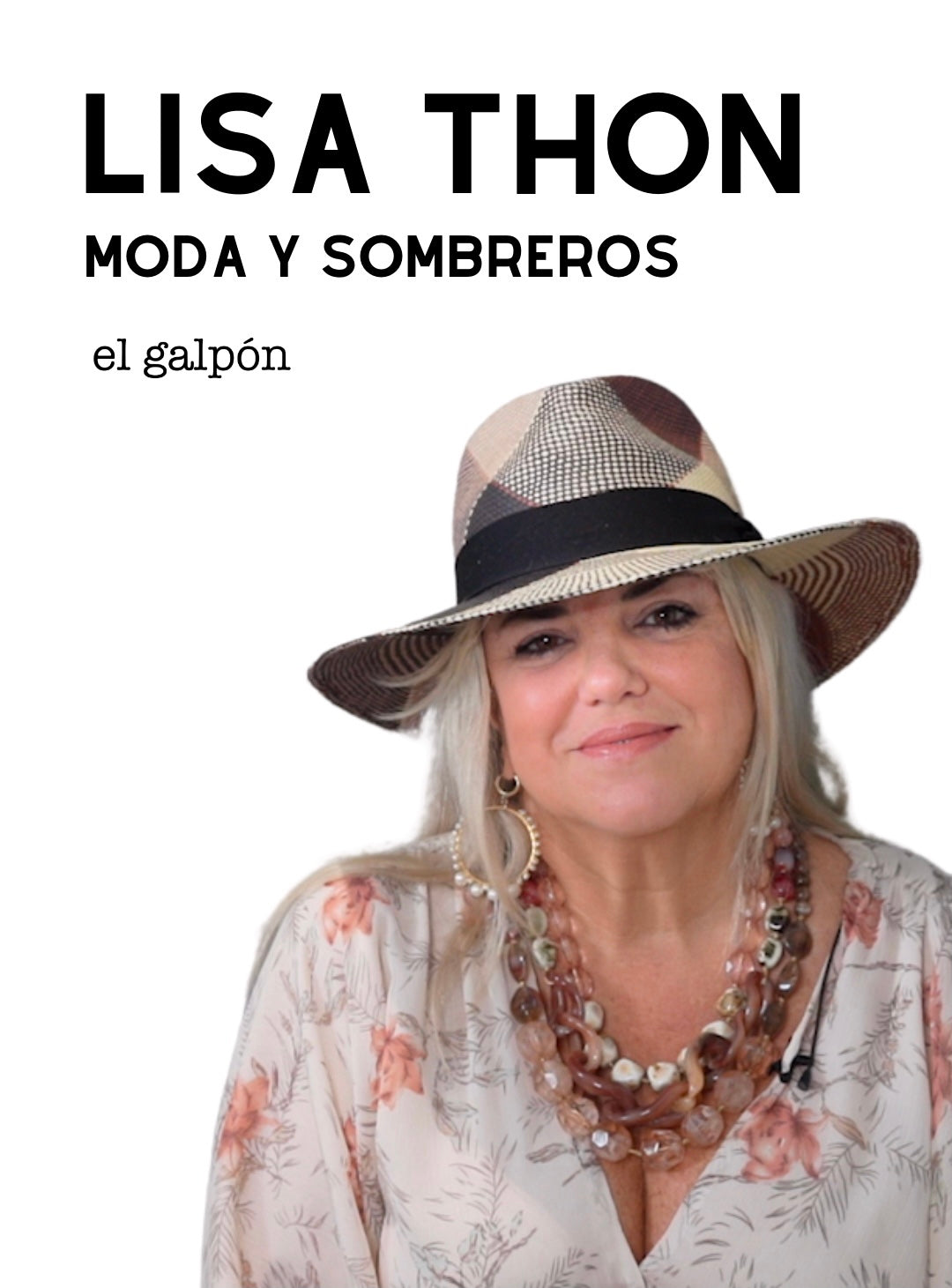
El Galpon
Moda y Sombreros con la Diseñadora Lisa Thon
Los sombreros siempre han sido símbolo de distinción, clase y modernidad. A través de los años y temporada tras temporada le han servido de inspiración o complemento a los diseñadores alrededor del mundo.
Tuvimos la oportunidad de hablar con la diseñadora de moda puertorriqueña Lisa Thon, reconocida por su estilo femenino y moderno. A lo largo de su carrera y colecciones ha implementado los SOMBREROS en sus inspiraciones de moda. Conoce parte de su historia aquí.
Pendiente a más videos e historias …. Stay Tuned!
---
Hats have always been a symbol of distinction, class and modernity. Over the years and season after season they have served as inspiration or complement to designers around the world.
We had the opportunity to speak with the Puerto Rican fashion designer Lisa Thon, known for her feminine and modern style. Throughout her career and collections she has implemented HATS in her fashion inspirations.
Learn about part of its history here.
Stay Tuned for more videos and stories!
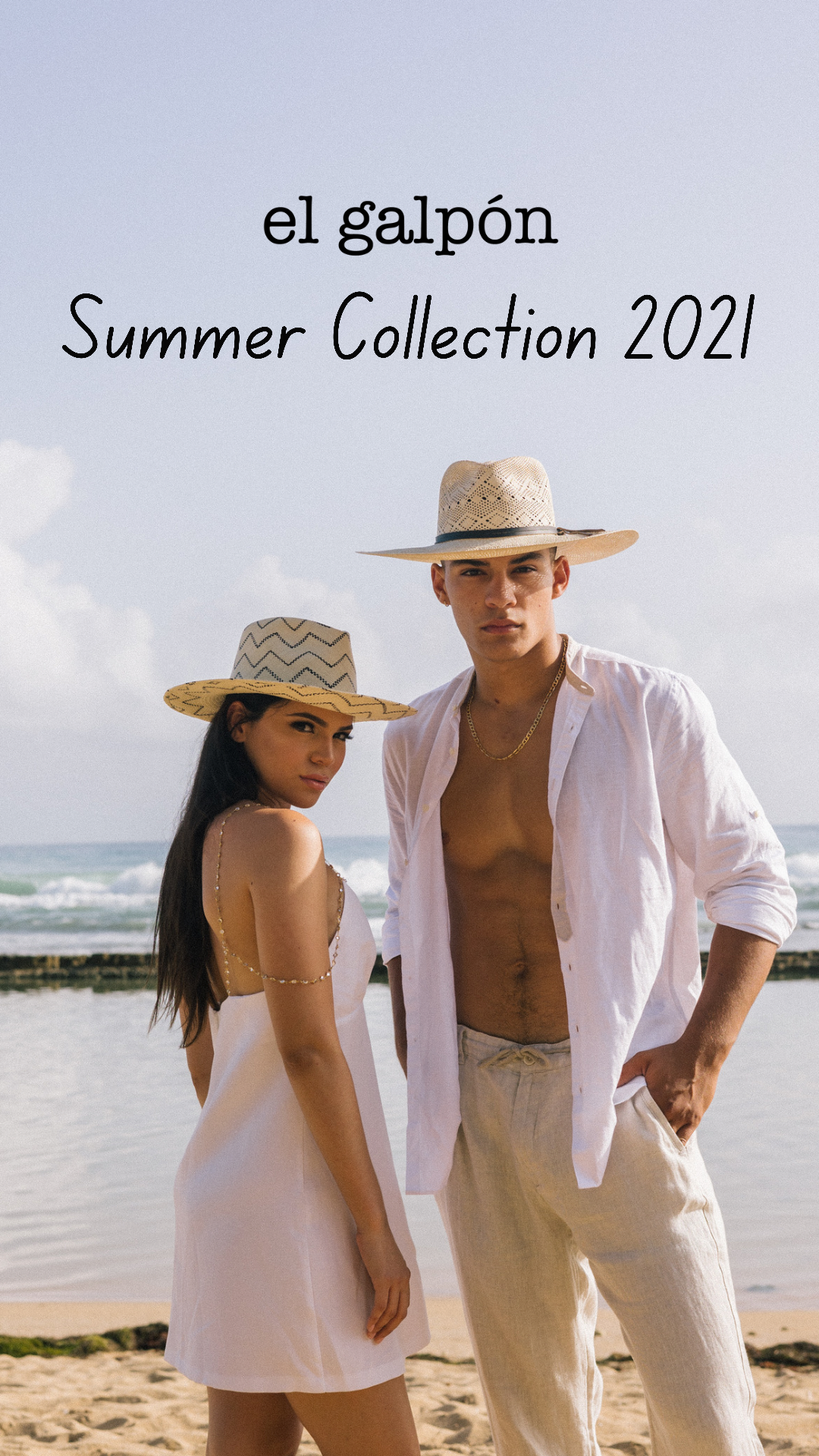
El Galpon
Llego la nueva temporada y con ella la nueva colección de Sombreros de El Galpón. En esta colección de verano optamos por llevar todo natural, negro, colores nude, más terminación, más calidad de tejido y diseños exclusivos.
A continuación, les vamos a estar mostrando cada estilo de esta colección.
Pétalos:
Es el único sombrero que tiene un toque de color, pero dentro de la gama de los colores nude, suaves, negro, gris, natural y rust. Decidimos llamarlo Pétalos porque a partir de su trenzado en la corona, los colores empiezan hacer la forma de unos pétalos alrededor de todo el sombrero.
Flecos:
En este sombrero combinamos el natural con el negro. Su ala mide específicamente 8 cm. Fleco es único porque el artesano cuando termina de tejer la copa tiene que anudar los diferentes hilos que salen para afuera, hacia el final del ala, con diferentes tonalidades. Es un sombrero que requiere mucha habilidad manual y mucha sapiencia.
Zig Zag:
Este sombrero es muy especial porque tiene tejido dentro del sombrero. Cuando los artesanos tejen, tienen que ir añadiendo la pajilla negra y creando el patrón. La cinta de este estilo es de paja en trenza y terminada con un nudo.
Lace:
Es un sombrero de estilo Alón. Es perfecto para más protección del sol. El Lace tiene una secuencia de tejido única. Las líneas negras son pajillas que se van agregando en cada tejido haciendo esta forma espectacular que lo hacen parecer como una cinta.
Chevron:
Este sombrero fue llamado así debido a que tiene un patrón de flechas que van en una dirección al que se le llama Chevron. Es 100% orgánico porque no tiene nada que no sea paja pura. Es sólo sombrero, no tiene cinta, no tiene nada. Es tejido a mano completamente.
Herringbone:
Este sombrero es todo patrón con colores naturales y negro. Tiene ala plana y baja con aproximadamente 12 cm que lo hacen el largo perfecto para cubrirte del sol. Es un sombrero de playa, para ir al bote, para protegerte o para estar súper fashion.
Ene Herringbone:
Utilizamos el mismo patrón y diseñamos este sombrero, que es un ala más corta. Este estilo esta pensado para una persona más chica o una persona que no se quiera proteger tanto del sol. Es un sombrero más de paseo, de uso para todos los días.
Surf:
Un sombrero que empieza a tejerse con una forma de ola, que llega desde la punta de la corona hasta el ala.
Crochet:
De un estilo Favorito en la pasada temporada quisimos darle un toque diferente y para la colección de verano diseñamos crochet. Tejido completamente a mano con paja natural y negra. Otro elemento nuevo y distintivo es su cinta que esta hecha completamente natural y perfecta para el verano. Un sombrero liviano.
Wrangler:
Un sombrero totalmente ventilado, para que estés bien fresco. El tejido tiene una forma de estrella y llega toda la ventilación hasta el ala. Terminado con una cinta de piel. Combina el natural de la paja con marrón de la cinta.
Y aquí les hemos presentado Summer Collection 2021. ¿Cual es tu favorito?
Aquí te dejamos el link para que le des un vistazo.
https://elgalpon.net/collections/verano-2021-summer
---
Summer Collection 2021
The new season has arrived and with it the new collection of Hats from El Galpón. In this summer collection we choose to wear all natural, black, nude colors, more finish, more quality of fabric and exclusive designs.
Next, we are going to be showing you each style of this collection.
Petalos:
It is the only hat that has a touch of color, but within the range of nude, soft, black, gray, natural and rust colors. We decided to call it Petals because from its braiding on the crown, the colors begin to form the shape of petals around the entire hat.
Flecos:
In this hat we combine the natural with the black. Its brim measures specifically 8 cm. Fringe is unique because the craftsman when he finishes weaving the cup has to knot the different threads that come out, towards the end of the brim, with different shades. It is a hat that requires a lot of manual skill and a lot of wisdom.
Zig Zag:
This hat is very special because it has fabric inside the hat. When the artisans weave, they have to add the black straw and create the pattern. The ribbon in this style is made of straw in braid and finished with a knot.
Lace:
It is an Alón style hat. It is perfect for more protection from the sun. The Lace has a unique weave sequence. The black lines are straws that are added to each fabric making this spectacular shape that makes it look like a ribbon.
Chevron:
This hat was so named because it has a pattern of arrows that go in one direction called Chevron. It is 100% organic because it has nothing other than pure straw. It's just a hat, it doesn't have a ribbon, it doesn't have anything. It is completely hand-woven.
Herringbone:
This hat is all pattern with natural colors and black. It has a flat and low brim with approximately 12 cm that make it the perfect length to cover you from the sun. It is a beach hat, to go to the boat, to protect yourself or to be super fashion.
Ene Herringbone:
We used the same pattern and designed this hat, which is a shorter brim. This style is designed for a smaller person or a person who does not want to protect so much from the sun. It is one more hat for a walk, to be used for every day.
Surf:
A hat that begins to be woven with a wave shape, which reaches from the tip of the crown to the brim.
Crochet:
From a Favorite style last season we wanted to give it a different touch and for the summer collection we designed crochet. Woven entirely by hand with natural and black straw. Another new and distinctive element is its ribbon that is made completely natural and perfect for summer. A light hat.
Wrangler:
A fully ventilated hat, so you are very cool. The fabric has a star shape and all the ventilation reaches the brim. Finished with a leather strap. Combine the natural straw with brown ribbon.
And here we have presented Summer Collection 2021. What is your favorite?
Here is the link for you to take a look
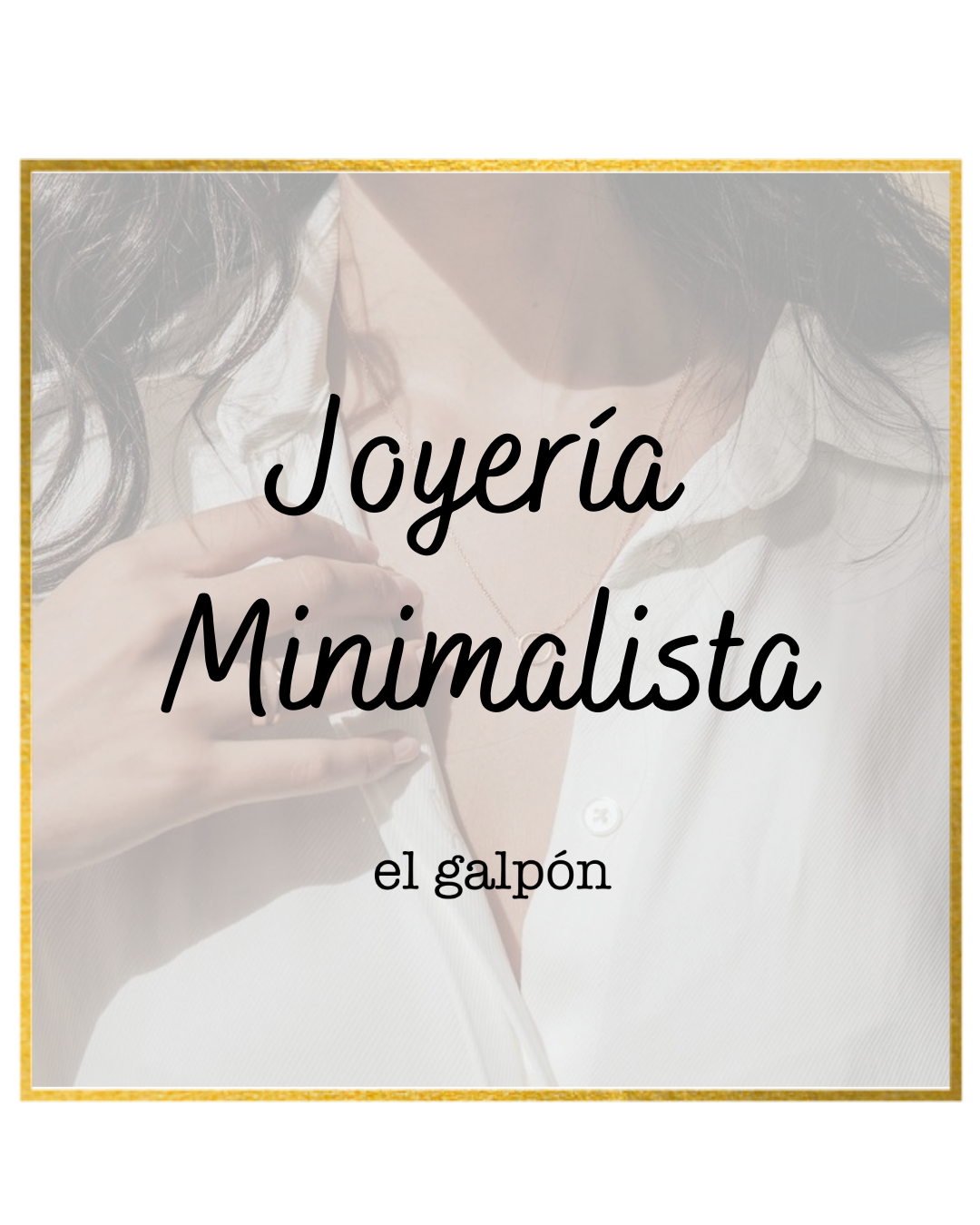
El Galpon
En toda la industria de la moda, constantemente surgen nuevas tendencias, estilos y accesorios a nuestro alrededor, y todos tienen su propio estilo único. Una tendencia que es muy popular en la actualidad es la joyería minimalista. Aunque parecería tarea fácil encontrar y combinar los accesorios perfectos no siempre es así. En el Blog de hoy te vamos a estar dando varios truquitos para que triunfes con joyería minimalista. ¡Sigue Leyendo!
¿Qué es la joyería minimalista?
Comencemos desde lo más básico. Este estilo de joyería se ha vuelto cada vez más popular en los últimos años, junto con el minimalismo en general; la joyería no es el único lugar donde encontrará minimalismo, y es un concepto completo que se puede aplicar a casi todo, incluida la moda en general.
Sin embargo, cuando se trata de joyería minimalista, precisamente, los criterios no son tan claros, ya que los accesorios desafían el concepto de minimalismo en primer lugar, pero estas piezas de arte las joyas minimalistas pueden elevar un atuendo de manera significativa, para encontrar el perfecto equilibrio.
En esencia, la joyería minimalista se compone de piezas que se centran en líneas delicadas y formas geométricas básicas, tal vez adornadas con un pequeño adorno aquí o allá, pero despoja de todo glamour y brillo adicional.
Disponible en El Galpón
¿Qué joyería minimalista me conviene?
Puedes estar seguro de que este estilo se puede adaptar a cualquier persona. Una cosa que a muchas personas les gusta tener en cuenta al elegir cualquier joya es cómo el color del metal complementa su tono de piel. Si su piel tiene tonos más fríos, las joyas de plata lo resaltarán más, y las joyas de rosa u oro resaltarán los tonos en una piel más cálida. Si tu piel es neutra, puedes salirte con la tuya ya que cualquier tono puede quedarte perfecto. Pero al fin y al cabo esto es cuestión de gustos.
Disponible en El Galpón
¿Cómo puedo usar joyería minimalista?
Una de las mejores características de este estilo de joyería es que combina con casi todos los outfits. También se puede usar para cualquier ocasión. Otra buena característica que no podemos dejar pasar es que la joyería minimalista es atemporal. Esto lo hace increíblemente versátil y hace que sea más viable poder invertir en una pequeña colección de piezas de mayor calidad.
Ya sea que los planes sean un BBQ en verano en familia, la fiesta de cumpleaños de un amigo o incluso un evento más formal, como una gala o ceremonia, no es necesario que cambies las joyas, con solo que cambies de atuendo esta bien, tu joyería minimalista combinará con cualquier outfit.
Generalmente algunas piezas tienden a parecer un poco más formales que otras, incluso en el mundo de la joyería minimalista, y piezas como esta pulsera pueden considerarse un poco más elegantes, pero todavía podría vestirse para algo menos formal.
Disponible en El Galpón
Por otro lado, anillos como estos son se podrían mezclar y combinar para adaptarse para el uso diario. Pero, si los usara en una noche elegante o en un evento importante, aún luciría igual de elegante y solo permitirían que la atención se sintiera atraída por el atuendo en sí, en lugar de distraerse con los accesorios.
Disponible en El Galpón
Muchas personas somos fanáticas de los diferentes estilos de accesorios, el brillo y el glamour pero tambiénnos vendría bien un poco más de simplicidad a veces y la joyería minimalista es perfecta. Cuéntanos… ¿Cual es tu estilo favorito de accesorios?
Disponible en El Galpón
---
Minimalist Jewelry
Throughout the fashion industry, new trends, styles, and accessories are constantly emerging around us, and everyone has their own unique style. One trend that is very popular today is minimalist jewelry. Although it would seem an easy task to find and combine the perfect accessories, it is not always like that. In today's Blog we are going to be giving you several tricks so that you can succeed with minimalist jewelry. Keep reading!
What is minimalist jewelry?
Let's start from the basics. This style of jewelry has become increasingly popular in recent years, along with minimalism in general; Jewelry is not the only place where minimalism is to be found, and it is a complete concept that can be applied to almost everything, including fashion in general.
However, when it comes to minimalist jewelry, precisely, the criteria are not that clear, as accessories challenge the concept of minimalism in the first. but this art expression, the minimalist jewelry can elevate an outfit significantly, to find the perfect balance.
At its core, minimalist jewelry is made up of pieces that focus on delicate lines and basic geometric shapes, perhaps adorned with a little embellishment here or there, but stripped of all extra glitz and glamor.
What minimalist jewelry suits me?
You can be sure that this style can be adapted to anyone. One thing that many people like to consider when choosing any jewelry is how the color of the metal complements your skin tone. If your skin has colder tones, silver jewelry will bring it out more, and rose or gold jewelry will bring out the tones in warmer skin. If your skin is neutral, you can get away with it as any shade can be perfect. But at the end of the day this is a matter of taste.
How can I wear minimalist jewelry?
One of the best characteristics of this style of jewelry is that it combines with almost all outfits. It can also be used for any occasion. Another good feature that we cannot miss is that minimalist jewelry is timeless. This makes it incredibly versatile and makes it more viable to be able to invest in a small collection of higher quality.
Whether the plans are a summer family BBQ, a friend's birthday party or even a more formal event, such as a gala or ceremony, it is not necessary to change the jewelry, just change your outfit is fine, your minimalist jewelry will match any outfit.
Generally, some pieces tend to look a bit more formal than others, even in the world of minimalist jewelry, and pieces like this bracelet can be considered a bit more elegant but you could still dress for something less formal.
On the other hand, rings like these could be mixed and matched to suit everyday wear. But, if you were to wear them to a fancy evening or important event, it would still look just as stylish and they would only allow attention to be drawn to the outfit itself, rather than being distracted by accessories.
Many of us are fans of different accessory styles, glitter and glamor but we could also use a little more simplicity at times and minimal jewelry is perfect. Tell us… What is your favorite style of accessories?
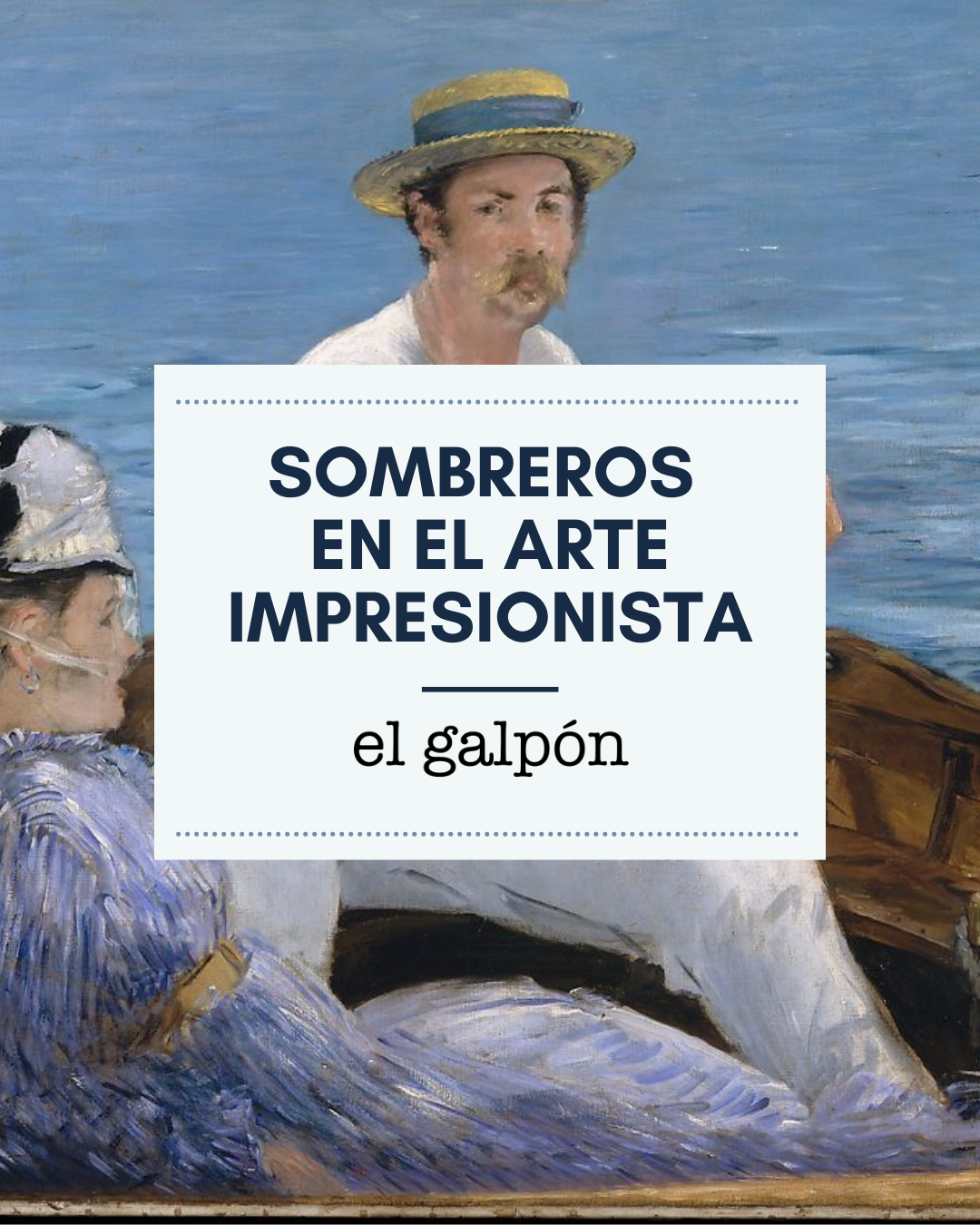
El Galpon
Sombreros en el arte Impresionista
Si algo caracterizo al Impresionismo además de las pinceladas rápidas y la captación de la luz, es la representación de la vida moderna en Paris en el siglo XIX. Estos pintores tenían la predilección por las escenas espontáneas en cafés, el teatro y la ópera, el circo, el hipódromo y el ocio al aire libre. Todas estas actividades para los artistas estaban estrechamente relacionadas con el mundo de la moda y los sombreros fueron grandes protagonistas. Junto con la vestimenta, los sombreros, participaron en la construcción de la imagen de una sociedad parisina que vivía una etapa de grandes cambios políticos, avances tecnológicos e ideas filosóficas.
Aquí te estaremos mostrando alguno de los sombreros mas famosos e impresionantes en este estilo de Arte y como bono te incluimos algunos estilos que estan disponibles en El Galpón.
Inicialmente, en el caso de los sombreros, para poder comprarlos era necesario encargarlos antes. Pero a mediados del siglo aparecieron las máquinas de coser transformando la industria del sombrero convirtiéndolo en un accesorio masivo. Esto lo podemos apreciar en Chez le modiste (1882) de Edgar Degas, la primera obra de una serie de pasteles dedicados a las sombrererías de Paris. La pintura es protagonizada por las jóvenes burguesas de Paris probándose sombreros de seda, plumas, paja y raso con adornos azules, rojos y blancos. Hoy día este estilo de sombrero le llamamos Pamelas. Las podemos ver en diferentes colores, con diferentes cintas y diferentes adornos.
Cómo por ejemplo en las tres versiones de Chez le modiste (1882)
Pamelas
El Galpón
Lo más habitual para los parisinos era llevar un sombrero junto a su atuendo de día. No solo Degas se interesó por las telas y los accesorios. Artistas como Manet, y Toulouse Lautrec se esmeraron por recrearlos en sus obras con gran detalle como signo del consumo de la modernidad.
Spring Edouard Manet
Toulouse-Lautrec
Actualmente durante la época de primavera y verano los sombreros son llevados con diferentes tocados y diseños que los complementan. En el Galpón tenemos estas opciones disponibles.
En el Arte Impresionista otro de los sombreros mas presentes fue el Boater, hoy día conocido como el Pra Pra. Este estilo de sombrero fue utilizado tanto por hombres como mujeres. En el arte vemos el estilo boater presentado en múltiples ocasiones en los días de verano en el mar o largos paseos relajantes. Actualmente el sombrero Pra Pra siguen siendo llevado en lugares tropicales y momentos de paseo y aventura.
Gustave Caillebotte "El Bal du Moulin de la Galette"
Boating, Edouard Manet
Estilo Pra Pra disponible en El Galpón
Por otro lado las pinturas de Berthe Morisot o la propia Cassatt han sido un ejemplar de la mujer moderna. Young Woman with a Straw Hat (1884) de Morisot y Young Woman in a Black and Green Bonnet (1890) de Cassatt, reflejan la tendencia de usar los sombreros más altos con ornamentos más sobrios. La propia Morisot también fue representada en Portrait of Berthe Morisot by Edouard Manet (1872) en la que la artista posa con un sombrero negro alto rodeado de un tul. Con una pose similar, mirando al espectador con un medio plano, Toulouse Lautrec retrato a la Suzanne Valadon, otra pintora francesa, in Portrait of Suzanne Valadon (1885). La mujer viste un sombrero alto negro con una pequeña decoración que lo rodea que también combina con el color de su vestido.
Berthe Morisot, Young Woman with a Straw Hat (1884)
Young Woman in a Black and Green Bonnet (1890) de Cassatt
Portrait of Berthe Morisot by Edouard Manet (1872)
Portrait of Suzanne Valadon (1885)
El sombrero que utilizaban estas mujeres era el Bonnet, el modelo más usado en los próximos años. Aquel nuevo estilo de sombrero se caracterizaba por ser alto, más aún en los looks de día, y era adornado con flores o tela. Si bien durante la primera mitad del siglo XIX los sombreros femeninos eran ostentosos decorados con flores, cintas, pieles y plumas; a finales del siglo aparecieron nuevos estilos. Las capelinas de ala ancha y los tocados, más pequeños, conquistaron las noches y el arte.
Elisabeth Louise Vigée
Por su lado, los sombreros masculinos seguían siendo muy sobrios. El modelo de moda era el sombrero de copa alta, también conocido como galera o chistera, con ala corta y copa recta. Pero a finales del siglo también se introdujo el bombín con ala corta y copa redondeada, otro modelo muy popular entre los hombres parisinos.
La moda masculina se puede evidenciar en obras como Oarsman in a Top Hat (1878) de Gustave Caillebotte. Esta pieza inmortaliza el nuevo estilo de la chistera. El artista retrata a un hombre, aparentemente de clase alta, navegando; una de las actividades de ocio favoritas del artista para sus pinturas. A pesar del calor de verano, el hombre decidió quitarse la chaqueta pero dejar su sombrero, reflejando la importancia de dicho accesorio y de la moda en general en aquella época.
Oarsman in a Top Hat (1878) de Gustave Caillebotte
La elegancia impregnaba todas las actividades como se puede apreciar en Le Déjeuner sur l'Herbe (1866) de Édouard Manet. Los retratados están en un picnic pero los hombres visten de traje, y uno de ellos un sombrero fez, usado generalmente en Turquía y al norte de África.
Le Déjeuner sur l'Herbe (1866) de Édouard Manet
A diferencia de los géneros académicos, en las pinturas impresionistas no hay temas religiosos, ni históricos. Las pinturas impresionistas representaban temas triviales sobre la vida urbana en Paris en la Bella Epoque. Pero no solo retratan las preferencias de los sombreros a medida que pasaba el tiempo, sino que también era un síntoma de una nueva sociedad. Con ello, surgió el ciudadano moderno, o el flaneur según el poeta Baudelaire, que vagueaba fascinado por cada rincón de la ciudad. La experiencia urbana y moderna marco un antes y un después y de igual manera lo pudimos notar en los sombreros.
Gustave Caillebotte. Calle de París, día lluvioso, 1877
¿Que te parece la representación de estos sombreros 'impresionista' hoy día?
Nuestros favoritos siguen siendo La Pamela, El Pra Pra y los que incluyen diferentes diseños y tocados. Aquí te dejamos el link de nuestra tienda para que le des un vistazo alguno de estos estilos.
https://elgalpon.net/collections/verano-summer
---
Hats in Impressionist art
If something characterized Impressionism in addition to the quick brushstrokes and the capture of light, it is the representation of modern life in Paris in the nineteenth century. These painters had a predilection for spontaneous scenes in cafes, the theater and opera, the circus, the racetrack, and outdoor leisure. All these activities for artists were closely related to the world of fashion and hats were great protagonists. Along with clothing, hats, they participated in the construction of the image of a Parisian society that was experiencing a period of great political changes, technological advances and philosophical ideas.
Here we will be showing you some of the most famous and impressive hats in this style of Art and as a bonus we include some styles that are available in El Galpón.
Initially, in the case of hats, to be able to buy them it was necessary to order them beforehand. But in the middle of the century, sewing machines appeared, transforming the hat industry, turning it into a massive accessory. We can see this in Edgar Degas's Chez le modiste (1882), the first work in a series of pastels dedicated to the millinery of Paris. The painting is carried out by the young bourgeois of Paris trying on hats of silk, feathers, straw and satin with blue, red and white ornaments. Today we call this style of hat Pamelas. We can see them in different colors, with different ribbons and different ornaments.
Chez le modiste (1882)
Pamelas
El Galpón
The most common thing for Parisians was to wear a hat with their day outfit. Not only Degas was interested in fabrics and accessories. Artists such as Manet and Toulouse Lautrec went to great lengths to recreate them in their works in great detail as a sign of the consumption of modernity.
Spring Edouard Manet
Toulouse-Lautrec
Currently during the spring and summer season, hats are worn with different headdresses and designs that complement them. In El Galpón we have these options available.
In Impressionist Art, another of the most popular hats was the Boater, today known as the Pra Pra. This style of hat was used by both men and women. In art we see the boater style presented on multiple occasions on summer days at sea or long relaxing walks. Currently the Pra Pra hat continues to be worn in tropical places and moments of walk and adventure.
Gustave Caillebotte "El Bal du Moulin de la Galette"
Boating, Edouard Manet
Pra Pra available at El Galpón
On the other hand, the paintings of Berthe Morisot or Cassatt herself have been exemplary of modern women. Young Woman with a Straw Hat (1884) by Morisot and Young Woman in a Black and Green Bonnet (1890) by Cassatt reflect the trend of wearing the taller hats with more sober ornaments. Morisot herself was also depicted in Portrait of Berthe Morisot by Edouard Manet (1872) in which the artist poses with a tall black hat surrounded by tulle. With a similar pose, looking at the viewer with a flat medium, Toulouse Lautrec portrayed Suzanne Valadon, another French painter, in Portrait of Suzanne Valadon (1885). The woman wears a tall black hat with a small decoration surrounding it that also matches the color of her dress.
Berthe Morisot, Young Woman with a Straw Hat (1884)
Young Woman in a Black and Green Bonnet (1890) de Cassatt
Portrait of Berthe Morisot by Edouard Manet (1872)
Portrait of Suzanne Valadon (1885)
The hat that these women used was the Bonnet, the most used model in the coming years. That new style of hat was characterized by being tall, even more so in daytime looks, and was adorned with flowers or fabric. Although during the first half of the 19th century, women's hats were ostentatiously decorated with flowers, ribbons, furs and feathers; at the end of the century new styles appeared. The wide-brimmed capelines and the smaller headdresses conquered the nights and the art.
Elisabeth Louise Vigée
For their part, men's hats were still very sober. The fashion model was the high top hat, also known as a galley or top hat, with a short brim and a straight crown. But at the end of the century the bowler hat with a short brim and rounded crown was also introduced, another very popular model among Parisian men.
Menswear can be evidenced in works such as Gustave Caillebotte's Oarsman in a Top Hat (1878). This piece immortalizes the new style of the hat. The artist portrays a man, apparently of upper class, sailing; one of the artist's favorite leisure activities for his paintings. Despite the summer heat, the man decided to take off his jacket but leave his hat, reflecting the importance of this accessory and of fashion in general at that time.
Oarsman in a Top Hat (1878) de Gustave Caillebotte
Elegance permeated all activities, as can be seen in Le Déjeuner sur l'Herbe (1866) by Édouard Manet. Those portrayed are on a picnic but the men wear suits, and one of them a fez hat, generally used in Turkey and North Africa.
Le Déjeuner sur l'Herbe (1866) de Édouard Manet
Unlike academic genres, there are no religious or historical themes in Impressionist paintings. Impressionist paintings depicted trivial themes about urban life in Paris at the Bella Epoque. But they not only portrayed hat preferences as time passed, it was also a symptom of a new society. With this, the modern citizen emerged, or the flaneur according to the poet Baudelaire, who wandered fascinated by every corner of the city. The urban and modern experience marked a before and after and in the same way we could notice it in the hats.
Gustave Caillebotte. Calle de París, día lluvioso, 1877
What do you think of the representation of these 'impressionist' hats today?
Our favorites are still La Pamela, El Pra Pra and those that include different designs and headdresses. Here we leave you the link of our store so that you can take a look at some of these styles.
https://elgalpon.net/collections/verano-summer
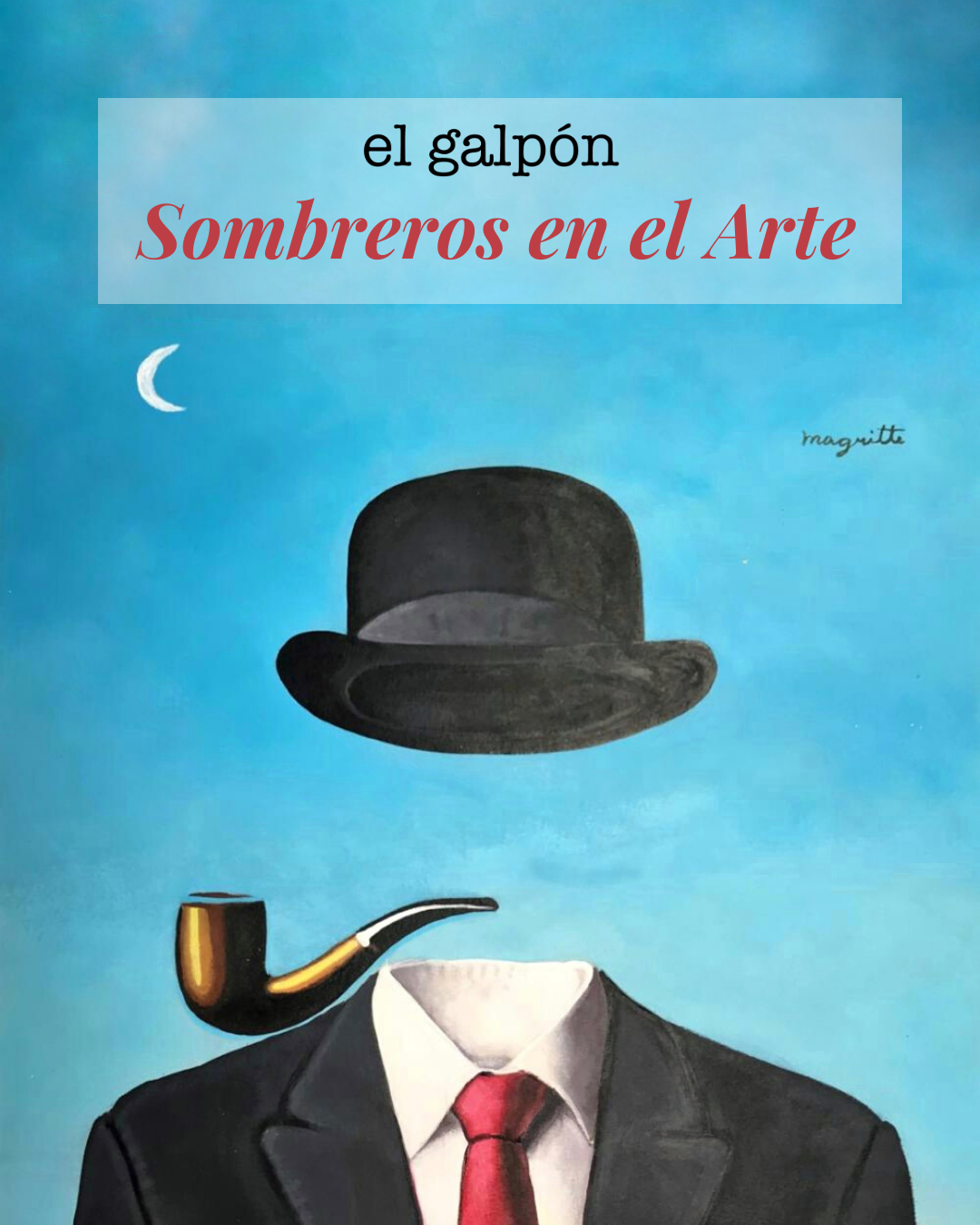
El Galpon
Desde la Antigua Grecia al retrato renacentista, de las pinturas de Johannes Vermeer a los impresionistas, de Matisse a Magritte; el arte ha retratado la evolución estética y funcional de los SOMBREROS desde sus inicios.
Johannes Vermeer
Henri Matisse
René Magritte
Lo vemos en pinturas, esculturas y se describe en la literatura. Los sombreros se reflejan en todo tipo de expresión artística. Desde lo mas practico hasta el simbolismo, los sombreros comenzaron a usarse como una distinción de estatus social y gusto individual.
Casco alado de Mercurio
Sombrero pétaso (Antigua Grecia)
Sombrero Pileus o Frigio más tarde adoptado en la revolución Francesa
Los avances en el arte de la sombrerería permitieron el desarrollo de tejidos o estampados, y con ello, el origen de un nuevo uso: como simple decoración para enmarcar el rostro.
Este accesorio en particular ha acompañado a la humanidad desde la antigüedad. Antes de que se perfeccionara el arte de la ropa, la gente se cubría la cabeza para protegerse de los peligros del clima. Al igual que la ropa, los sombreros nacieron para que los humanos se protegieran del calor del sol o de temperaturas muy bajas. Pero a medida que avanzaban las civilizaciones, también lo hacían las costumbres. Así como la función de los sombreros también ha evolucionado.
Sombrero frigio en la revolución francesa
Las obras de arte nos ayudan a comprender diferentes épocas y culturas. No solo es un placer contemplarlos, sino que el arte también funciona como reflejo de la sociedad mostrándonos sus tradiciones, códigos, moda, gastronomía, etc. Los retratos han logrado mostrarnos la vida cotidiana de diferentes épocas. En este sentido, el sombrero es una prenda con una capacidad de transformación muy poderosa. Gracias a los cuadros, que han servido de documento, descubrimos que estos accesorios han cambiado de función.
Elisabeth Louise Vigée Le Brun
Desde la antigüedad, se pueden encontrar personajes con cabezas o cabellos ornamentados en frescos y esculturas. Un dato curioso: en Creta se encontraron las representaciones más antiguas de boinas y sombreros, que aparecen decorados con varios colores y con diferentes texturas. En la antigua Grecia, los archivos pictóricos revelan el gusto de los griegos por decorar su cabello con perlas o cintas o con peinados elaborados como trenzas retorcidas. Pero solo comenzamos a ver sombreros con más frecuencia en la Edad Media. En ese período su uso utilitario se vio favorecido por el fuerte frío. Esto se debió a que, en ese momento, se creía que las enfermedades respiratorias entraban por la cabeza. Debemos recordar que el conocimiento científico no existía. Así es como encontramos los sombreros hechos de pieles y materiales gruesos.
Aun así, las pinturas de la época nos muestran una vez más el interés constante de las personas por decorar sus sombreros y crear diferentes estilos a la medida de sus gustos. Tal es el caso de la "caperuza", un sombrero muy popular entre las mujeres que usaban una manta conocida como "capelina" que les llegaba a los hombros. Sirvió para cubrirse de la lluvia, pero en diferentes obras podemos ver cómo cambian de forma, iniciando así una nueva moda. Echemos un vistazo a los retratos de Jan van Eyck, en concreto a su obra más conocida "Retrato de Giovanni Arnolfini y su esposa" (1434). La mujer posee una capelina elaboradamente trabajada que cae a los lados de su cabeza. Su esposo también posa con un sombrero de gran tamaño, probablemente para demostrar su riqueza.
"Retrato de Giovanni Arnolfini y su esposa"
Sombrero "Caperuza"
Desde el siglo XVIII, el rococó adornaba las cabezas de hombres y mujeres de una manera inigualable. Francia se había consolidado como la cuna de la moda, siendo su mejor modelo a seguir la reina María Antonieta, que marcó un antes y un después. Los pintores estaban obsesionados con ella, pero solo Élisabeth Louise Vigée Le Brun logró trabajar para la familia real. Los sombreros de la reina estaban entre los más extravagantes y lujosos. Sus telas exóticas combinaban con su atuendo, y generalmente estaban decoradas con grandes plumas. Y de eso se trataba este período: adornos excesivos y una atmósfera menos racional y más pasional.
Reina María Antonieta
Reina María Antonieta
Reina María Antonieta
El final del siglo XIX vio los cambios más significativos en la sociedad y, por supuesto, en la pintura. El espíritu de los nuevos cambios también llegó a la moda. Los impresionistas se han dedicado a observar su entorno y plasmarlo en lienzos. Basta remitirse a las obras de Seurat, Manet, Gauguin o Renoir para conocer en primera persona las costumbres de las nuevas clases sociales. Incluso en los parques, las mujeres llevaban sombreros elegantes pero sutiles que muchas veces no cumplían con su función. Lejos de los adornos, la gente comenzó a usar sombreros más pequeños y modestos.
Georges Seurat
Edouard Manet
Paul Gauguin
Pierre-Auguste Renoir
Los paradigmas culturales cambian, pero los sombreros siguen acompañando a las personas. Algunos son más llamativos; otros son rígidos, redondos y sobrios como los de Magritte, y otros simplemente protagonizan naturalezas muertas con otros efectos personales. Hoy en día los códigos de vestimenta son más relajados que en otras épocas y por eso reservamos estos complementos para fechas especiales. Pero sin duda, los sombreros son más que adornos; están llenos de historias y continúan acompañándonos en momentos especiales.
Aquí les recomiendo Sombreros que son Realmente una Obra de Arte... ¡Todos disponibles en El Galpón!
---
Hats in art
From Ancient Greece to Renaissance portraits, from the paintings of Johannes Vermeer to the Impressionists, from Matisse to Magritte; art has portrayed the aesthetic and functional evolution of hats since its beginnings. We see it in paintings, sculptures, and described in literature. Hats are reflected in all types of artistic expression. From practicality to symbolism, hats began to be used as a distinction of social status and individual taste. Advances in the art of millinery allowed the development of fabrics or prints, and with it, the origin of a new use: as a simple decoration to frame the face.
This particular accessory has accompanied mankind since ancient times. Before the art of clothing was perfected, people covered their heads in order to protect themselves from the hazards of the weather. Like clothing, hats were born for humans to protect themselves from the heat of the sun, or from very low temperatures. But as civilizations advanced, so did the customs. Thus, the function of hats has evolved.
Works of art help us to understand different epochs and cultures. Not only is it a pleasure to contemplate them, but art also functions as a reflection of society by showing us its traditions, codes, fashion, food, etc. Portraits have managed to show us the daily life of different periods. In this sense, the hat is a garment with a very powerful ability to transform. Thanks to paintings, which have served as a document, we discover that these accessories have changed their function.
Since ancient times, characters with ornamented heads or hair can be found in frescoes and sculptures. A curious fact: in Crete were found the oldest representations of berets and hats, which appear decorated with various colors and with different textures. In ancient Greece, pictorial archives reveal the Greeks' taste for decorating their hair with pearls or ribbons or with elaborate hairstyles such as twisted braids. But we only began to see hats more frequently in the middle Ages. In that period their utilitarian use was encouraged by the strong cold weather. This was because, at that time, it was believed that respiratory diseases entered through the head. We must remember that scientific knowledge did not exist. This is how we find hats made of fur and thick materials.
Even so, the paintings of the time show us once again the constant interest of people to decorate their hats and create different styles to suit their tastes. Such is the case of the "caperuza", a very popular hat among women who used a blanket known as a "capelina" that reached their shoulders. It served to cover themselves from the rain, but in different works we can see how they change their shape, thus initiating a new fashion. Let's take a look at the portraits of Jan van Eyck, specifically his best-known work "Portrait of Giovanni Arnolfini and his wife" (1434). The woman possesses an elaborately worked capelina that falls to the sides of her head. Her husband also poses with an oversized hat, probably to demonstrate his wealth.
Since the 18th century, Rococo ornamented the heads of men and women in an unparalleled manner. France had established itself as the cradle of fashion, its best role model being Queen Marie Antoinette, who marked a before and after. Painters were obsessed with her but only Élisabeth Louise Vigée Le Brun managed to work for the royal family. The Queen's hats were among the most extravagant and luxurious. Their exotic fabrics matched her attire, and they were usually decorated with large feathers. And that was what this period was all about: excessive ornaments and a less rational and more passionate atmosphere.
The end of the 19th century saw the most significant changes in society and, of course, in painting. The spirit of new changes also reached fashion. Impressionists have dedicated themselves to observe their surroundings and capture them on canvas. Like a flaneur, these artists became admirers of modern society. It is enough to refer to the works of Seurat, Manet, Gauguin, or Renoir to know in first person the customs of the new social classes. Even in the parks, women wore elegant but subtle hats that often did not fulfill their function. Far from ornaments, people began to wear smaller, more modest hats.
Cultural paradigms change, but hats continue to accompany people. Some are showier; others are rigid, rounded, and sober like those of Magritte, and still, others simply star in still lifes with other personal belongings. Nowadays, dress codes are more relaxed than in other times and that is why we reserve these accessories for special dates. But without a doubt, hats are more than just ornaments; they are full of stories and continue to accompany us in special moments.
